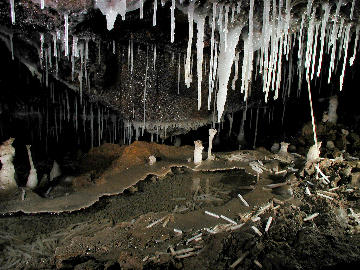The Virtual Cave: Cave Conservation

Graffiti in the form of spray paint destroys the natural beauty of caves

Cave formations are very easily damaged, so care must be taken
Caves are delicate places where even the most careful of human visitors can easily leave their mark. Caves have very few mechanisms for repair: a broken formation or a name written on the wall will stay that way perhaps indefinitely.
People visit caves for many reasons but for animals, caves provide food and shelter. Caves are also a path into the water table, so cave pollution can poison a vital resource for our own community. It is up to us to protect caves when we visit them. With this in mind the Virtual Cave offers these guidelines for personal conduct in caves.
- Leave the cave as you found it. We applaud cleaning up trash, of course, but leave formations, rocks, animals, archeological remains, and historic features intact. Carry all your trash out, including that which is biodegradable.
- If you need to urinate or defecate, wait until you're outside the cave, or use a bottle and carry it out. Those of us who go on long cave trips really do this, however unpleasant it may sound. Human wastes are bad for cave organisms, unhealthy for ground water (which may be your drinking water), and also tend to break down slowly. Bad smells will linger for a very long time.
- Avoid disturbing cave animals. Cave dwelling species of bats are important for pest management and pollination of plants.They are particularly vulnerable to human interference when they are hibernating, and when they are bringing up their young. The best thing to do is stay out of bat caves when they are in use.
- Stick to one trail to minimize damage to the floor and walls of the cave. Walking and climbing can destroy delicate formations and transfer mud from caver to clean rock and flowstone.
- Avoid touching formations, particularly with muddy gloves, clothing, and boots. Formations include flowstone floors and walls. If you must climb on flowstone, use clean gloves, clean clothing, and clean, non-marking shoes to prevent transferring dirt or skin oils to the rock.
- Look where you're going. This is the best way to avoid breaking formations and leaving dirty footprints. It sounds simple, but the cave environment is full of surprises.
- Cave safely. Taking care of yourself prevents accidents and accidental damage.
Cave Conservation Links
NSS Cave Conservation Division
American Cave Conservation Association
National Cave and Karst Management Symposium
NSS Cave Conservancies Committee
(this site has links to all known cave conservancies)
Bat Conservation International
